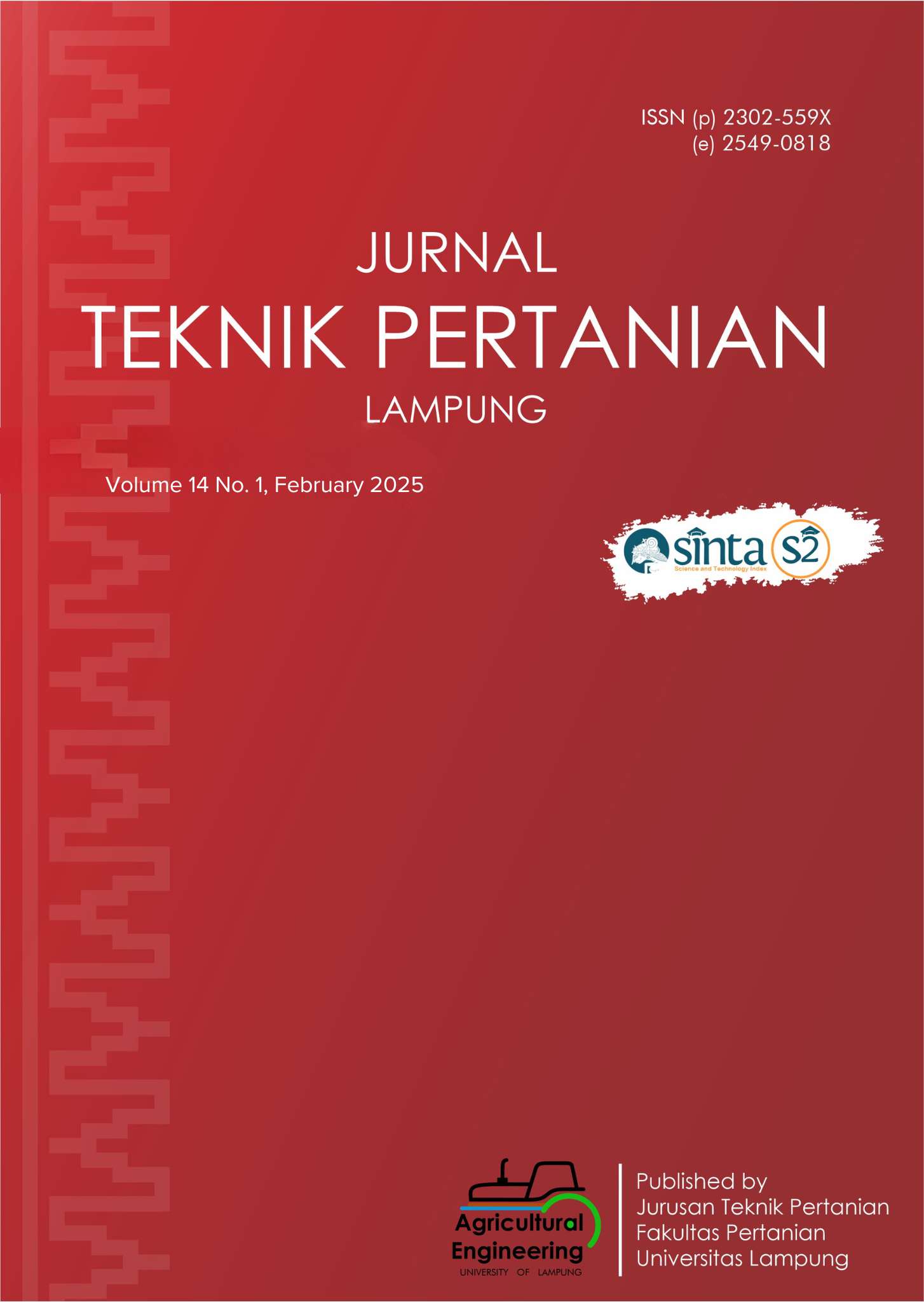Impact of High-Temperature Heating on the Chemical Stability and Sensory Quality of Red Palm Oil
DOI:
https://doi.org/10.23960/jtep-l.v14i1.215-225 Abstract View: 380
Abstract View: 380
Abstract
Red palm oil (RPO) is known for its high carotenoid content, particularly β carotene and α-carotene, which provide significant provitamin A activity. However, it is susceptible to oxidation during frying and results in nutrient loss and quality degradation. This study investigates the effects of high temperatures and prolonged heating durations on the chemical and sensory properties of RPO. The experiment involved heating RPO at three different temperatures (140°C, 180°C, and 220°C) for durations ranging from 2 to 10 hours. Chemical analysis included peroxide values, free fatty acids, and changes in functional groups through Fourier Transform Infrared (FTIR) spectroscopy. Sensory evaluations focused on aroma and color alterations due to heating. Results showed that prolonged heating of RPO at high temperatures led to significant increase in peroxide values, and the formation of oxidation products, including aldehydes and ketones, which negatively impacted the sensory qualities. The oil darkened, and a burnt aroma developed, reducing overall sensory appeal. These findings provide new insights into the optimal frying conditions to preserve the nutritional and sensory qualities of RPO, particularly by minimizing heating duration and temperature.
Keywords: Nutritional value, Prolonged heating, Red palm oil, Sensory attributes, Thermal oxidation.
Downloads
References
Al Amin, M., Ali, M. A., Alam, M.S., Nahar, A., & Chew, S.C. (2023). Oxidative degradation of sunflower oil blended with roasted sesame oil during heating at frying temperature. Grain and Oil Science and Technology, 6(1), 34–42. https://doi.org/10.1016/j.gaost.2022.11.004
Al-Degs, Y.S., Al-Ghouti, M., & Salem, N. (2011). Determination of frying quality of vegetable oils used for preparing falafel using infrared spectroscopy and multivariate calibration. Food Analytical Methods, 4, 540-549. http://link.springer.com/article/10.1007/s12161-011-9201-9
Aminah, S. (2010). Bilangan peroksida minyak goreng curah dan sifat organoleptik tempe pada pengulangan penggorengan. Jurnal Pangan dan Gizi, 1(1), 7–14.
Andarwulan, N., Sadikin, Y.T., & Winarno, F.G. (1997). Pengaruh lama penggorengan dan penggunaan adsorben terhadap mutu minyak goreng bekas penggorengan tahu-tempe, Buletin Teknologi dan Industri Pangan, 8(1), 41-45.
Association of Analytical Chemist. (2005). Official Methods of Analysis of AOAC. 18th ed. Washington DC (US).
Berger, K.G. (1985). The Use of Palm Oil In Frying. Malaysian Palm Oil Promotion Council: Malaysia.
BSN (Badan Standarisasi Nasional). (2013). SNI 3741:2013 – Minyak Goreng. Badan Standarisasi Nasional, Jakarta.
BSN (Badan Standarisasi Nasional). (2021). Standar Nasional Indonesia 2901-2021. Syarat mutu CPO (Crude Palm Oil). Badan Standarisasi Nasional, Jakarta.
Budiyanto, Silsia, D., Efendi, J., & Janika, R. (2010). Perubahan kandungan β-karoten, asam lemak bebas dan bilangan peroksida minyak sawit merah selama pemanasan. AGRITECH, 30(2), 75-78.
Budiyanto, Syafnil, & Meliah. (2007). Pengaruh suhu dan waktu deodorisasi terhadap kandungan asam lemak bebas dan tingkat kesukaan pada bau minyak sawit merah (red palm oil). SEMIRATA BKS-PTN Barat Bidang Ilmu Pertanian, Pekan Baru 23-26 Juli 2007, 250-253. http://repository.unib.ac.id/id/eprint/7955
Burhan, A.H., Rini, Y.P., Faramudika, E., & Widiastuti, R. (2018). Penetapan angka peroksida minyak goreng curah sawit pada penggorengan berulang ikan lele. Jurnal Pendidikan Sains (JPS), 6(2), 48–53. https://doi.org/10.26714/jps.6.2.2018.48-53
Elaine, E., Fong, E.L., Pui, L.P., Goh, K.M., & Nyam, K.L. (2022). The frying stability comparison of refined palm oil, canola oil, corn oil, groundnut oil, and sunflower oil during intermittent frying of french fries. Journal of Food Measurement and Characterization, 17, 518–526. https://doi.org/10.1007/s11694-022-01646-1
Falade, A.O., & Oboh, G. (2015). Thermal oxidation induces lipid peroxidation and changes in the hysico-chemical properties and β-carotene content of arachis oil. International Journal of Food Science, 2015(1), 806524. https://doi.org/10.1155/2015/806524
Gao, H.X., Yu, J., Chen, N., & Zeng, W.C. (2020). Effects and mechanism of tea polyphenols on the quality of oil during frying process. Journal of Food Science, 85(11), 3786–3796. https://doi.org/10.1111/1750-3841.15470
Gerde, J., Hardy, C., Fehr, W., & White, P.J. (2007). Frying performance of no- trans, low-linolenic acid soybean oils. Journal of the American Oil Chemists’ Society, 84(6), 557-563. https://doi.org/10.1007/s11746-007-1066-0
Ghazali, Z., Nik, W.B.W., Bulat, K.H.K., Ani, F.N., & Xian, L.F. (2006). The Effect of light on the oxidative stability of palm olein. Proceedings of the 1st International Conference on Natural Resources Engineering and Technology, 24-25th July 2006, Putrajaya, Malaysia. 631-637. https://core.ac.uk/download/pdf/11776971.pdf
Henon, G., Kemeny, Z., Resceg, K., Zwobada, F., & Kovari, K. (1997). Degradation of linolenic acid during heating. JAOCS, Journal of the American Oil Chemists' Society, 74(12), 1615-1617. https://doi.org/10.1007/s11746-997-0087-z
Herlina, H., Astryaningsih, E., Windrati, W.S., & Nurhayati, N. (2017). Tingkat kerusakan minyak kelapa selama penggorengan vakum berulang pada pembuatan ripe banana chips (RBC). Jurnal Agroteknologi, 11(02), 186–193. https://doi.org/10.19184/j-agt.v11i02.6527
Husain, F., & Marzuki, I. (2021). Pengaruh temperatur penyimpanan terhadap mutu dan kualitas minyak goreng kelapa sawit. Jurnal Serambi Engineering, 6(4), 2270–2278.
Jatmika, A., & Guritno, P. (1997). Sifat fisikokimiawi minyak goreng sawit merah dan minyak goreng sawit biasa. Jurnal Penelitian Kelapa Sawit, 5(2), 127–138.
Karoui, I.J., Dhifi, W., Ben Jemia, M., & Marzouk, B. (2011). Thermal stability of corn oil flavoured with thymus capitatus under heating and deep-frying conditions. Journal of the Science of Food and Agriculture, 91(5), 927–933. https://doi.org/10.1002/jsfa.4267
Kemp, S.E., Hollowood T., & Hort J. (2009). Sensory Evaluation A Practical Handbook. John Wiley & Sons: United Kingdom.
Ketaren, S. (2012). Pengantar Teknologi Minyak dan Lemak Pangan. UI Press: Jakarta.
Kittipongpittaya, K., Panya, A., Prasomsri, T., & Sueaphet, P. (2020). Tropical oil blending and their effects on nutritional content and physicochemical properties during deep fat frying. Journal of Nutritional Science and Vitaminology, 2020(66), S206–S214. https://doi.org/10.3177/jnsv.66.S206
Legasari, L., Riandi, W., Febriani, R.A., & Pratama, W. (2023). Analisis kadar air dan asam lemak bebas pada produk minyak goreng dengan metode gravimetri dan valumetri. Jurnal Pendidikan Kimia dan Ilmu Kimia, 6(2), 51-58. https://doi.org/10.33627/re.v6i2.1228
Li, X., Li, J., Wang, Y., Cao, P., & Liu, Y. (2017). Effects of frying oils’ fatty acids profile on the formation of polar lipids components and their retention in French fries over deep-frying process. Food Chemistry, 237, 98-105. https://doi.org/10.1016/j.foodchem.2017.05.100
Manurung, M.M., Suaniti, N.M., & Putra, G.K.D. (2018). Kualitas minyak goreng akibat lama pemanasan. Jurnal Kimia, 12(1), 59-63. https://doi.org/10.24843/JCHEM.2018.v12.i01.p11
Marantika, J. (2016). Penyebab Ketengikan Dalam Minyak. (Online) diakses pada 3 Maret 2024 dari https://www.scribd.com/doc/314232069/Penyebab-Ketengikan-Dalam-Minyak
Mulyati, A.T., Pujiono, E.F., & Lukis, A.P. (2015). Pengaruh lama pemanasan terhadap kualitas minyak goreng kemasan kelapa sawit. Jurnal Wiyata, 2(2), 1-7.
Nagendran, B., Unnithan, U.R., Choo, Y.M., & Sundram, K. (2000). Characteristics of red palm oil alpha-carotene and vitamin E- rich refined oil for food uses. Food and Nutrition Buletin, 21(2), 189-194. https://doi.org/10.1177/156482650002100213
Nayak, P.K., Dash, U., Rayaguru, K., & Krishnan, K.R. (2016). Physio-chemical changes during repeated frying of cooked oil: A review. Journal of Food Biochemistry, 40(3), 371–390. https://doi.org/10.1111/jfbc.12215
Nugroho, A.J., Ibrahim, R., & Riyadi, P.H. (2014). Pengaruh perbedaan suhu pengukusan (steam jacket) terhadap kualitas minyak dari limbah usus ikan nila (Oreochromis niloticus). Jurnal Pengolahan Dan Bioteknologi Hasil Perikanan, 3(1), 21–29. https://ejournal3.undip.ac.id/index.php/jpbhp/article/view/4818
Nurdiani, I., Suwardiyono., & Kurniasari, L. (2021). Pengaruh ukuran partikel dan waktu perendaman ampas tebu pada peningkatan kualitas minyak jelantah. Jurnal Inovasi Teknik Kimia, 6(1). http://dx.doi.org/10.31942/inteka.v6i1.4451
Oboh, G., Falade, A.O., & Ademiluyi, A.O. (2014). Effect of thermal oxidation on the physico-chemical properties, malondialdehyde and carotenoid contents of palm oil. Rivista Italiana Sostanze Grasse, 91(1), 59–65.
Okiy, D.A., & Oke, O.L. (1986). Some chemical changes in heated palm oil. Food Chemistry, 21(3), 161-166. https://doi.org/10.1016/0308-8146(86)90014-2
Pramitha, D.A.I., Suantari, P.A., Gmelina, P.D., Suradnyana, I.G.M., & Yuda, P.E.S.K. (2022). Kualitas minyak oles yang diproduksi dari virgin coconut oil (VCO) dan bunga cengkeh dengan variasi suhu pemanasan. Jurnal Kimia, 16(2), 149–161. https://doi.org/10.24843/jchem.2022.v16.i02.p04
Puspitasari, S. (2013). Pengaruh Suhu Penggorengan Terhadap Kerusakan Kadar Vitamin E Pada Minyak Goreng. [Diploma Thesis], Fakultas Ilmu Kesehatan, Universitas Muhammadiyah Surabaya.
Putra, A.N., & Azara, R. (2021). Perbandingan kualitas minyak goreng dengan empat kali penggorengan pada minyak goreng kemasan dan curah. Jurnal Teknologi Agroindustri dan Pangan Tropis, 2(1), 9-14.
Rahayu, L.H., & Purnavita, S. (2014). Pengaruh suhu dan waktu adsorpsi terhadap sifat kimia-fisika minyak goreng bekas hasil pemurnian menggunakan adsorben ampas pati areb dan bentonit. Momentum, 10(2), 35–41. https://media.neliti.com/media/publications/115187-ID-pengaruh-suhu-dan-waktu-adsorpsi-terhada.pdf
Sahidin, S., Matsjeh, S., & Nuryanto, E. (2000). Degradasi β-karoten dari minyak sawit mentah oleh panas. Jurnal Penelitian Kelapa Sawit, 8(1), 39-50. https://iopri.co.id/journal/download/83
Siti, N.W., Tri Dewanti W, & Kuntanti. (2001). Studi Tingkat Kerusakan dan Keamanan Pangan Minyak Goreng Bekas (Kajian Dari Perbedaan Jenis Minyak Goreng dan Bahan Pangan yang Digoreng). [Research Report]. Faculty of Agricultural Technology, Universitas Brawijaya, Malang.
Sobhani, A., Mohammed, A.S., Ghobakhlou, F., & Ghazali, H.M. (2018). Determining the oxidative stability and quality of tiger nut (Cyperus esculentus) oil and its antioxidant activity during microwave heating. Revista Española de Nutrición Humana y Dietética, 22(1), 52–63.
Suroso, A.S. (2013). Kualitas minyak goreng habis pakai ditinjau dari bilangan peroksida, bilangan asam dan kadar air. Jurnal Kefarmasian Indonesia, 3(2), 77-88
Tena, N., Aparicio, R., & García-González, D.L. (2009). Thermal deterioration of virgin olive oil monitored by ATR-FTIR analysis of trans content. Journal of Agricultural and Food Chemistry, 57(22), 9997–10003. https://doi.org/10.1021/jf9012828
Downloads
Published
How to Cite
Issue
Section
License
Authors who publish with this journal agree to the following terms:
Authors retain copyright and grant the journal right of first publication with the work simultaneously licensed under a Creative Commons Attribution-ShareAlike 4.0 International Lice that allows others to share the work with an acknowledgement of the work's authorship and initial publication in this journal.
Authors are able to enter into separate, additional contractual arrangements for the non-exclusive distribution of the journal's published version of the work (e.g., post it to an institutional repository or publish it in a book), with an acknowledgement of its initial publication in this journal.
Authors are permitted and encouraged to post their work online (e.g., in institutional repositories or on their website) prior to and during the submission process, as it can lead to productive exchanges, as well as earlier and greater citation of published work (See The Effect of Open Access).
Jurnal Teknik Pertanian Lampung

JTEPL is licensed under a Creative Commons Attribution-ShareAlike 4.0 International License.













